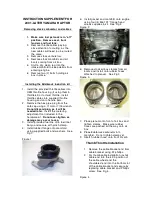
Check the tire pressure at least once a month.
Only check and correct tire pressures when
the tires are cold (
Y
page 483).
Checking the tire pressures manually
In order to determine and adjust the tire
pressures, proceed as follows:
X
Remove the valve cap of the tire you wish
to check.
X
Press the tire pressure gauge securely onto
the valve.
X
Read the tire pressure and compare it with
the recommended value on the Tire and
Loading Information placard on the
B-pillar on the driver's side of your vehicle.
X
If necessary, increase the tire pressure to
the recommended value (
Y
page 483).
X
If the tire pressure is too high, release air
by pressing down the metal pin in the valve
using the tip of a pen, for example. Then,
check the tire pressure again using the tire
pressure gauge.
X
Screw the valve cap onto the valve.
X
Repeat the steps for the other tires.
Tire pressure monitor
Important safety notes
If a tire pressure monitor is installed, the
vehicle's wheels have sensors installed that
monitor the tire pressures in all four tires. The
tire pressure monitor warns you when the
pressure drops in one or more of the tires. The
tire pressure monitor only functions if the
correct wheel electronics units are installed
in all wheels.
The tire pressure monitor has a yellow
warning lamp in the instrument cluster for
indicating pressure loss/malfunctions (USA)
or pressure loss (Canada). Depending on how
the warning lamp flashes or lights up, a tire
pressure that is too low or a malfunction in
the tire pressure monitor is displayed:
R
if the warning lamp is lit continuously, the
tire pressure on one or more tires is
significantly too low. The tire pressure
monitor is not malfunctioning.
R
USA only: if the warning lamp flashes for
60 seconds and then remains lit constantly,
the tire pressure monitor is malfunctioning.
G
Warning
Each tire, including the spare (if provided),
should be checked at least once a month
when cold and inflated to the inflation
pressure recommended by the vehicle
manufacturer on the Tire and Loading
Information placard on the driver’s door B-
pillar or the tire inflation pressure label on the
inside of the fuel filler flap. If your vehicle has
tires of a different size than the size indicated
on the Tire and Loading Information placard
or the tire inflation pressure label, you should
determine the proper tire inflation pressure
for those tires.
As an added safety feature, your vehicle has
been equipped with a tire pressure monitoring
system (TPMS) that illuminates a low tire
pressure telltale when one or more of your
tires are significantly underinflated.
Accordingly, when the low tire pressure
telltale illuminates, you should stop and check
your tires as soon as possible, and inflate
them to the proper pressure. Driving on a
significantly underinflated tire causes the tire
to overheat and can lead to tire failure.
Underinflation also reduces fuel efficiency
and tire tread life, and may affect the vehicle's
handling and stopping ability. Please note that
the TPMS is not a substitute for proper tire
maintenance, and it is the driver's
responsibility to maintain correct tire
pressure, even if underinflation has not
Tire pressure
487
Tires and wheels
Z
Содержание S-Class 2011
Страница 1: ...S Class Operator s Manual...
Страница 4: ......
Страница 42: ...40...
Страница 77: ...Vehicle equipment 76 SmartKey 76 Doors 82 Trunk 85 Side windows 89 Sliding sunroof 93 75 Opening and closing...
Страница 286: ...284...
Страница 364: ...362...
Страница 446: ...444...
Страница 447: ...Vehicle equipment 446 Engine compartment 446 Maintenance 451 Care 452 445 Maintenance and care...
Страница 462: ...460...
Страница 480: ...478...
Страница 520: ...518...
Страница 521: ...519...
Страница 522: ...520...
Страница 524: ...Order no 6515 2341 13 Part no 221 584 23 83 Edition A 2011 2215842383t 2215842383...
















































